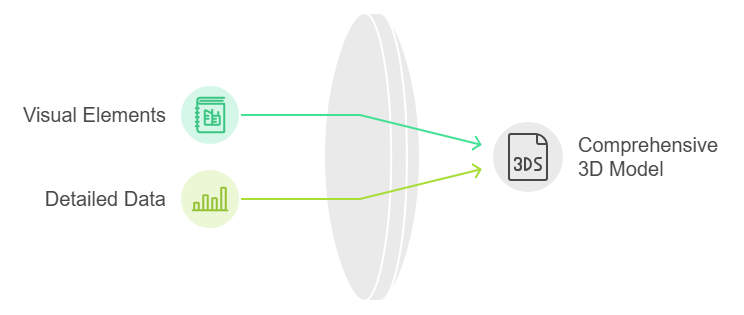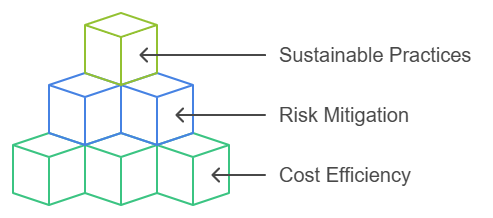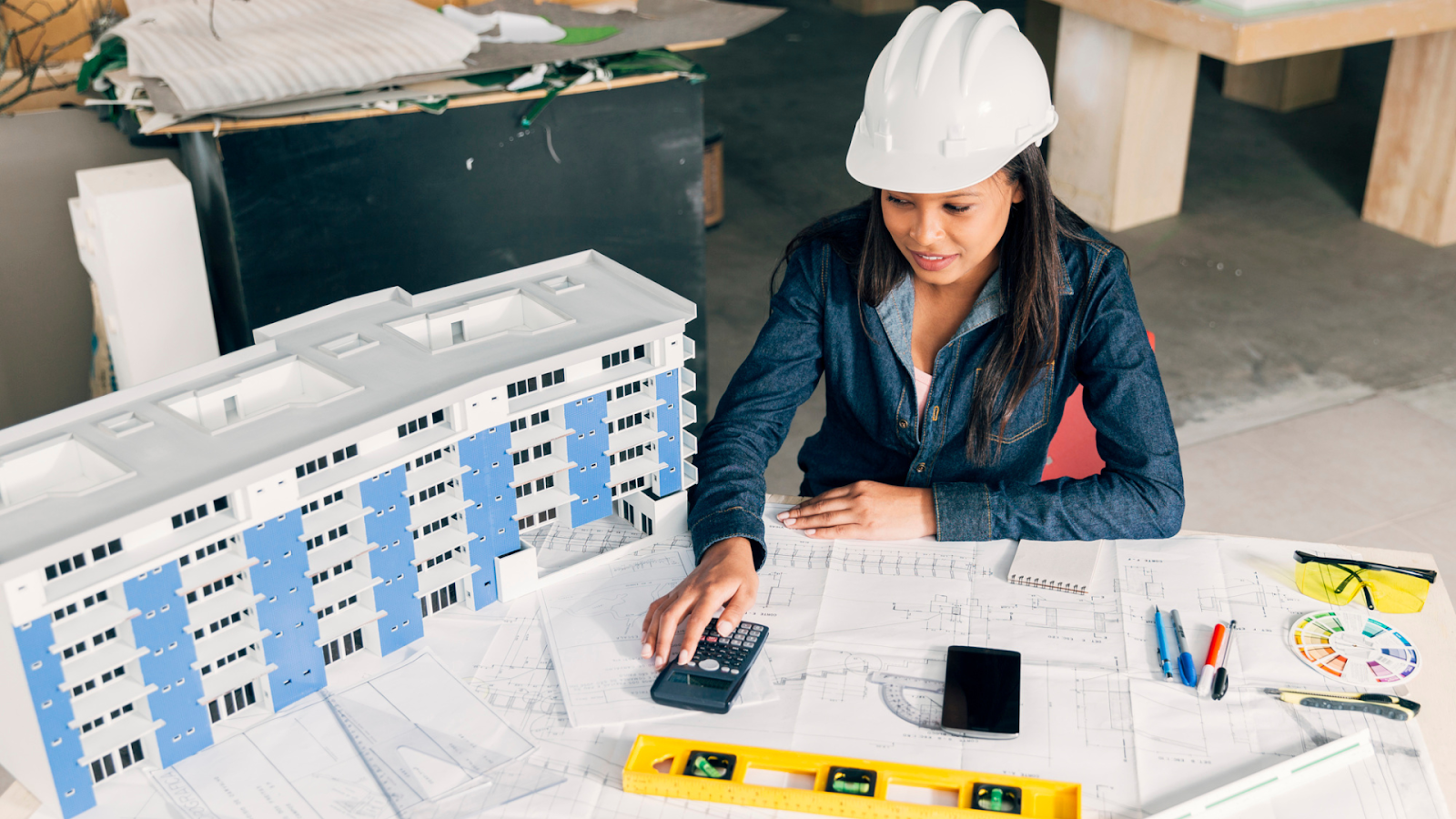Have you ever tried organising a construction project without BIM? It’s like assembling a jigsaw puzzle in the dark! Building Information Modelling (BIM) has become a game-changer for how projects are designed, built, and managed in the construction world.
First and foremost, it’s essential to highlight that incorporating the BIM process is mandatory for construction-related projects in several countries, including the UK, the USA, Australia, and Russia. BIM must be utilized throughout the entire project lifecycle to ensure smooth execution while also staying on track with project deadlines and avoiding significant challenges.
Whether you’re a professional or just entering the world of BIM, understanding how it works is crucial for staying ahead. In today’s article, we’ll dive deep into the BIM levels, benefits, and future of the construction industry. Let’s start!
What is BIM and Its Role in Construction Projects

Building Information Modelling (BIM) is a digital approach for designing, coordinating, and managing construction projects. It creates a 3D model that combines visual elements, such as drawings, with detailed data, like materials, costs, and specifications.
As modern-day projects get more complex in terms of design, coordination, scale, and related services, BIM plays an essential role in modern construction projects. Let’s find out how:
- Visualisation – BIM enables project teams and clients to view the project in 3D. It improves understanding of the design, supports decision-making, and helps with accurate cost estimates.
- Improved Project Efficiency – Using a digital model allows teams to identify potential issues, such as clashes between architecture, structural, electrical, and mechanical systems. The issues are solved even before the construction begins, which leads to better planning, fewer delays, and cost savings.
- Data-Driven Decision Making – BIM offers detailed data on materials, quantities, and performance, which enhances decision-making from design to operations and maintenance.
- Lifecycle Management – It supports the complete lifecycle of a building. After completion, the model can be used for ongoing maintenance, repairs, and upgrades, ensuring long-term value.
- Collaboration and Coordination – BIM enhances collaboration by providing a shared digital platform for architects, engineers, contractors, and other stakeholders. It ensures everyone works with the same up-to-date information, reducing errors and conflicts.
Now that we’ve discussed the role of BIM, let’s take a closer look at the BIM levels that define its application and maturity in projects.
Overview of BIM Levels
BIM levels represent the maturity of the digital model, defining how information is created, shared, and managed at each stage. These levels highlight the evolution of a project’s digital representation—from basic document management to fully integrated, collaborative models used in design, collaboration, construction, and operation.
Understanding these levels allows you to manage resources effectively, minimise risks, and make informed decisions. It also ensures that projects are completed promptly, within budget, and meet the highest quality standards.
Alright, so we’ve navigated through the foundational aspects of BIM. Ready to explore how different BIM levels refine and elevate construction projects?
BIM Level 0 (2D Drawings with Less Collaboration)
BIM Level 0 is the most basic stage, where there is no collaboration between project teams, and designs are created using traditional methods. This level is typically seen in the early stages of projects or small-scale construction operations where digital workflows still need to be implemented.
At Level 1, BMI relies only on 2D drawings made with CAD (Computer-Aided Design). There is no centralised digital model or information management system. Project data is stored in individual files, often without integration across disciplines. While some digital drawings may be created, they are typically unmanaged and not part of an integrated or coordinated process.
Communication between teams is often done through traditional, paper-based methods, such as printed drawings, physical documents, and email. Without a single source of truth for project information, discrepancies, confusion, and potential errors are common. Revisions and updates are usually communicated informally, and there is a heavy reliance on manual workflows for tasks like document control, revisions, and approvals.
As projects become more complex, the limitations of Level 0 become increasingly clear. This highlights the need to transition to higher BIM levels, which allow for better collaboration and improved project outcomes. So, let’s move to BIM Level 1.
BIM Level 1 (2D Drawings & 3D Digital Models with Partial Collaboration)
At BIM Level 1, digital tools evolve with 3D CAD (Computer-Aided Design) models, mainly for conceptual design and visualisation. While 3D models help represent the initial design ideas, most project documentation still relies on 2D drawings, particularly for detailed design and construction.
BIM Level 1 introduces some collaboration, but it remains limited. Data is shared through a Common Data Environment (CDE), but integrating this data is often incomplete. The CDE stores and manages project documents, but it still needs to support real-time collaboration or coordinated workflows across all teams fully. This can cause inefficiencies, as collaboration is more manual and document-based than fully integrated.
A key aspect of BIM Level 1 is the adoption of British Standards (BS 1192) for information management. These guidelines ensure that collaboration, file naming, version control, and document management are consistent and organised across the project. It helps manage the flow of information.
Guidelines for Achieving Level 1
If you want to achieve Level 1 BIM, several key elements need to be addressed, such as:
- Defined Roles – The roles and responsibilities of all stakeholders should be clearly defined in line with the CIC BIM Protocol.
- Naming Convention – A standardised naming convention, like Uniclass 2015, should be adopted to ensure consistency across the project.
- Project Codes – Project-specific codes and spatial coordination must be developed and maintained using Industry Foundation Classes (IFC) standards.
- Information Sharing – Teams should share information using a Common Data Environment (CDE) or an Electronic Document Management System (EDMS) to make collaboration easier and more efficient.
- Information Hierarchy – An appropriate information hierarchy should support the CDE and the document repository.
BIM Level 1 shows progress in using digital tools and methods, but it still relies on 2D drawings and only allows partial collaboration. This limits the full potential of BIM. However, it helps the project teams to move towards a collaborative approach, which is important for reaching BIM Level 2 and beyond. Let’s discuss BIM Level 2.
BIM Level 2 (Multiple 3D Models with Full Collaboration)
In 2016, the UK Government made BIM Level 2 a requirement for all public sector construction projects. This was part of the Construction 2025 strategy to improve efficiency, cut costs, and encourage collaboration in the construction industry.
At BIM Level 2, everyone involved in the project, such as architects, designers, contractors, and other team members, creates their own 3D BIM models. Once these models are ready, the teams share their data in a Common Data Environment (CDE). This makes it easier for all stakeholders to see and coordinate the project, as they can work with a more complete view of the design.
Guidelines for Achieving Level 2
If you want to achieve Level 2 BIM, your organisation must first meet all the requirements for Level 1. In addition, CAD software should be used to support common file formats like Industry Foundation Class (IFC) or Construction Operations Building Information Exchange (COBie).
IFC is an open standard that allows data to be shared between different BIM software so stakeholders can work with compatible files no matter what software they use. COBie, on the other hand, is a format designed to make it easier to hand over facility management information.
BIM Level 2 marks a significant move towards a more collaborative and data-driven approach to construction. It sets the stage for BIM Level 3, which will take collaboration and integration even further. So, let’s discuss BIM Level 3.
BIM Level 3 (Integrated Process with Full Integration)
At BIM Level 3, the project uses a fully integrated model that becomes the core of all work processes. This single shared model combines all project data—like design, engineering, schedules, costs, and operations—in one place. It allows all stakeholders to access the information in real time and makes collaboration easy.
One important aspect of BIM Level 3 is open data standards like IFC (Industry Foundation Classes). With these standards, various teams can use different software tools without compatibility issues. They also allow data to flow seamlessly through all stages of a building’s lifecycle—from design and construction to maintenance.
BIM Level 3 is a key part of the UK government’s Digital Built Britain (DBB) strategy. This strategy focuses on advancing digital technologies in construction and aims to create a more integrated, data-driven approach to building and infrastructure projects. BIM Level 3 makes projects more innovative, sustainable, and efficient.
The DBB strategy also supports the development of smart cities and intelligent buildings. It integrates technologies like the Internet of Things (IoT), real-time data monitoring, and automated systems into the BIM process. This helps improve how buildings and infrastructure are designed, built, and managed, promoting better outcomes for construction and ongoing operations.
Guidelines for Achieving Level 3
The UK Government’s Level 3 Strategic Plan for BIM emphasises the need for global data sharing and better collaboration on projects. To make this happen, a new ‘Open Data’ standard must be created to ensure smooth data exchange across international projects.
Also, new contracts are needed to encourage teamwork and keep things consistent in BIM projects. Training public sector clients on BIM to take full advantage of its benefits, like improved efficiency and better project outcomes, is important.
BIM Level 3 represents the highest level of digital integration in the construction industry. It creates a fully collaborative environment where all project stakeholders work together on a single, shared model. This approach encourages better collaboration and more efficient project delivery. Let’s move to the next level, BIM Level 4.
BIM Level 4 (Additional “Time” Component along with Shared 3D Model)
BIM Level 4 goes beyond construction by focusing on social outcomes and well-being. It promotes human-centred design by highlighting sustainability, energy efficiency, and the overall quality of the built environment.
Level 4 also begins to assess the broader social impact of construction projects. This includes community engagement, the health & well-being of building occupants, and the project’s environmental footprint. Projects can deliver more value by integrating these social considerations into the BIM process.
Although Level 4 is still developing, it has a huge potential for social impact. Level 4 can reshape how projects are designed, delivered, and managed. Now, let’s move ahead and discuss BIM Level 5.
BIM Level 5 (Budget Analysis in Information Model)
As BIM maturity increases with each level, BIM Level 5 brings valuable improvements for project managers and their clients. At this level, stakeholders can determine cost estimation and schedule the entire project.
Stakeholders can manage and work within set budgets while tracking the project’s performance. In addition, project teams can directly connect costs to specific design elements, materials, and construction activities.
Moreover, stakeholders can use the model to analyse detailed budgets and compare actual costs with projected budgets. Also, they can predict how design changes, schedule delays, or unforeseen site conditions may affect finances.
The model also allows for quick budget adjustments based on ongoing analysis. For example, if a design change increases material costs, the model updates accordingly, sending alerts to the project manager and enabling quicker, data-driven decisions.
With this integration, all project stakeholders—clients, contractors, and suppliers—gain greater visibility into the project’s financial aspects. This transparency allows better collaboration and informed decisions based on real-time information.
As BIM advances, Level 5 sets the stage for more efficient, data-driven, and financially sustainable project delivery. Next comes BIM Level 6.
BIM Level 6 (Sustainability Analysis with Cost Estimation & Scheduled 3D Model)
BIM Level 6 is quickly becoming a preferred choice for construction projects. It allows stakeholders to perform sustainability analysis before construction begins. This enables them to assess the energy efficiency of the building and make informed decisions about materials and other factors.
BIM Level 6 incorporates sustainability analysis directly into the 3D model. At this level, project teams can assess the environmental impact of a building throughout its full lifecycle. Energy modelling tools integrated with BIM Level 6 predict how the building will perform in terms of energy consumption and carbon footprint.
In addition, BIM Level 6 allows stakeholders to evaluate the economic feasibility of green building solutions. For instance, considering an energy-efficient HVAC system, the model can calculate the initial cost, long-term savings, and carbon reduction potential.
BIM Level 6 also reduces risks, minimises waste, and ensures that the project meets both sustainability standards and financial targets. If you want to implement BIM architecture in your projects, BIM ASSOCIATES offers expert services to streamline your design, collaboration, and construction process.
So far, we have discussed all the levels of BIM – BIM Level 0, 1, 2, 3, 4, 5, and 6. Let’s move ahead and learn how these BIM levels can impact everyone’s life.
Benefits of BIM Levels

Building Information Modelling (BIM) has revolutionised the UK construction industry. Its collaborative and data-driven approach helps streamline processes, optimise resources, and reduce risks. Let us look at the benefits of BIM levels:
Cost and Time Savings
BIM’s 3D modelling capabilities allow for precise visualisation in the design phase. It easily identifies clashes or errors between plumbing, electrical, and structural components.
BIM also integrates time management (4D BIM) with the design model. This integration helps contractors visualise and track construction sequences, anticipate delays, and optimise workflows. The detailed timelines and simulations help improve coordination among contractors, suppliers, and other stakeholders.
Furthermore, BIM enhances material procurement by providing accurate quantity take-offs. It ensures that the right materials are ordered at the right time. This minimises wastage, optimises storage, and prevents delays caused by material shortages.
Risk Management
BIM improves risk management by offering a collaborative, transparent approach to project development. Potential risks can be identified early by centralising all project data in a shared model.
BIM also supports simulations and scenario planning and allows teams to predict unexpected site conditions, supply chain issues, or adverse weather and plan accordingly.
Additionally, BIM enables real-time monitoring of project progress. It allows project managers to track performance and promptly address any emerging risks or deviations from the schedule.
Sustainability
BIM plays a vital role in promoting sustainability in construction. It supports energy-efficient design, waste reduction, and sustainable material selection.
Energy modelling and performance simulations in BIM help design energy-efficient buildings that minimise operational energy consumption and reduce carbon footprints.
BIM also supports the life-cycle analysis of building materials. In addition, it helps reduce waste by providing accurate quantity take-offs. Moreover, BIM’s logistics planning helps optimise materials delivery, reducing transportation-related emissions and fuel consumption.
BIM helps make buildings more eco-friendly by supporting renewable energy features like solar panels and green roofs. It ensures these systems are well-designed and work efficiently by including them early in the planning process.
BIM also reduces the impact of transportation and promotes water conservation with smart plumbing designs that use less water. This makes sure sustainability is a key part of the building design from the very beginning.
Furthermore, BIM improves teamwork by helping architects, engineers, and contractors collaborate in real time. This reduces mistakes and rework, ensuring sustainable practices are followed throughout the project.
Now that you know the benefits of BIM levels, it’s crucial to understand how this technology has developed in the UK construction industry. Are you curious about where BIM is taking the UK construction industry next? Let’s delve into the future trends you can’t afford to miss.
The Rise of BIM in UK Construction & Its Future
Since 2011, the UK government has actively promoted BIM. In 2016, it made it mandatory for all public-sector projects to adopt BIM Level 2. Many local construction companies are now incorporating BIM into their projects.
The future of BIM in the UK is bright, driven by technological advancements, evolving project requirements, and a growing emphasis on sustainability. Here are the key trends shaping its trajectory:
- AI and Machine Learning – Integrating AI into BIM will streamline clash detection, cost estimation, and project planning tasks. These technologies will improve efficiency and provide data-driven insights, enhancing decision-making throughout the project lifecycle.
- 5D and 6D BIM – BIM is advancing beyond 3D modelling to include cost tracking (5D) and facility management (6D). These enhancements will leverage real-time data to optimise building performance, enable predictive maintenance, and ensure cost-effective operations.
- Digital Twins – Digital Twin technology will become a cornerstone of BIM, allowing for real-time monitoring and analysis of buildings. This approach will help optimise operational efficiency, extend the lifespan of assets, and improve sustainability by minimising resource consumption.
- Cloud Collaboration – Cloud-based platforms will enhance collaboration by providing seamless, real-time access to BIM models. Teams can interact virtually and stay updated on changes, regardless of physical location, improving coordination and project outcomes.
- Standardisation and Interoperability – The industry will see increased efforts toward standardisation and interoperability, ensuring smoother data exchange between BIM tools and stakeholders. This will simplify collaboration and drive consistency across projects.
These advancements promise to make BIM an even more indispensable tool in the UK’s construction industry, driving innovation, efficiency, and sustainability. As we discussed BIM levels, let’s wrap up with a quick summary!
Conclusion
Building Information Modelling (BIM) transforms construction by improving communication, data accuracy, and resource optimisation. As BIM advances, it enhances collaboration, data sharing, and workflow efficiency, leading to higher-quality, sustainable outcomes.
From design to the full integration of operations, BIM’s adoption ensures that projects evolve efficiently, reducing costs, mitigating risks, and improving overall project performance. Adopting BIM at each level and stage unlocks a path toward smarter, more sustainable, cost-effective construction.
Whether you’re just starting with BIM or already leveraging its power, embracing higher levels, and advancing through the stages, ensure your projects are delivered on time. It should be within budget and built to last. The future of construction is here, and BIM is leading the way.
Are you looking for BIM solutions?
BIM ASSOCIATES is your one-stop BIM Solution provider for Architecture and Structure. Their solutions help clients with better decision-making, cost-saving, efficient construction planning, and green earth initiatives.
FAQs (Frequently Asked Questions)
1. What is 3D, 4D, 5D, 6D, 7D in BIM?
Here’s the meaning of 3D, 4D, 5D, 6D, 7D in BIM:
- 3D BIM – Focuses on the spatial representation of a building or infrastructure project.
- 4D BIM – Adds the time dimension to 3D BIM.
- 5D BIM – Integrates cost data with the 3D model.
- 6D BIM – Includes sustainability and energy performance analysis.
- 7D BIM – Facilitates facility management by integrating operational and maintenance data.
- 8D BIM – Focuses on safety management by embedding risk assessments and hazard mitigation strategies into the BIM model.
2. What is the latest BIM standard?
ISO 19650 is an international standard that guides the secure management of information throughout the entire lifecycle of a built asset using BIM. It follows the same principles and requirements as the UK BIM Framework and is closely aligned with UK 1192 standards.
3. What are the four stages of BIM?
Here are the four stages of BIM:
- Stage 1: Analysis and Evaluation
- Stage 2: Planning, Design, and Construction
- Stage 3: Pre-Planning and Transition
- Stage 4: Facility Operations and Maintenance

